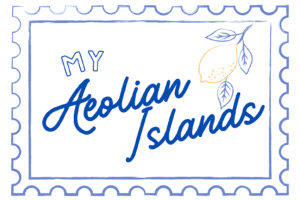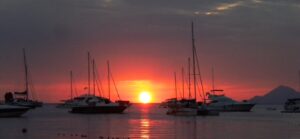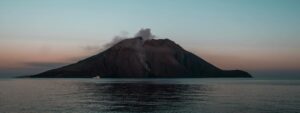Salina is the green heart of the Aeolian Islands, famous for its capers, Malvasia wine, stunning hiking trails, and unforgettable sunsets at Pollara.
It’s best to stay at least 2–3 nights, explore villages like Malfa, Lingua, and Santa Marina, and enjoy the island slowly, at its natural rhythm.
In this article
If you’d ask me about Salina, I would describe it as the gentle, green giant who always welcomes you with open arms. While Stromboli smokes and Lipari buzzes with energy, Salina feels calm, fertile, and deeply rooted in tradition. The island is draped in vineyards and caper bushes, framed by its two volcanic peaks, Monte Fossa delle Felci and Monte dei Porri, like twin guardians watching over the villages below.
The first time you set foot here, the air itself feels different. With its peaks rising out of the water like an emerald jewel, Salina has the scent of wild herbs carried on the breeze, the sweetness of Malvasia grapes ripening under the sun, and the salty freshness of the sea never far away. Life moves slowly on Salina, and that’s the point. People come here not just to see a place, but to feel a rhythm, one that whispers of nature, hospitality, and the art of living well.
Whether you’re sipping granita by the sea in Lingua, watching the sunset at Pollara, or hiking to the highest point in the entire archipelago, Salina has a way of leaving a mark on you. It’s not dramatic or loud. It’s quiet, graceful, and unforgettable.
How to reach Salina
Like all the Aeolian Islands, you’ll arrive by boat. The closest departure point is Milazzo, on the northern coast of Sicily, where ferries and hydrofoils depart several times a day. From Milazzo, the trip takes about 1.5 hours by hydrofoil, or a little longer if you choose the slower ferry. Check more info here.
Most boats dock at Santa Marina Salina, the island’s lively main port, where pastel houses line the seafront and cafés spill out onto the promenade. Santa Marina is also where you’ll find many of the island’s shops, boutiques, and gelaterie. It’s a great starting point, not just geographically but emotionally: there’s a sense of welcome here, as if the island is inviting you in before you venture out to its quieter corners.
A very different arrival experience awaits at Rinella, the second port on the south coast. Smaller, quieter, and tucked into a curve of black sand, Rinella feels more like stepping into a fishing village than a port town. There’s usually less crowd and fewer ferry rides, but if you prefer a softer landing, Rinella might just be your kind of arrival.
And while it’s not an official port, many visitors speak of truly “arriving” in Salina when they reach Pollara. This tiny hamlet is where the island shows its raw beauty most clearly. Standing on the cliffs at sunset, watching the sky turn shades of gold and violet over the sea, you’ll understand why so many fall in love with this place.
How to move around Salina
Salina is an island you can experience at many speeds, it just depends on how you like to travel. Some people rent a scooter and feel the wind in their hair as they circle the coastal roads. Others hop on the local bus and let the ride unfold slowly, village by village. And then there are those who lace up their hiking shoes and discover Salina step by step, through vineyards and chestnut woods. All of them are right.
Buses connect the main villages, Santa Marina, Malfa, Rinella, Lingua, and Pollara, and they’re a great option if you want to move around without worrying about parking. The routes are frequent in summer, a little more relaxed in spring and autumn.
If you want more independence, scooters and small cars are easy to rent at the ports. A scooter is perfect for two people, giving you freedom to stop wherever the view calls you, and on Salina, that’s often. A car is handy if you’re traveling with family or planning to carry beach gear, though roads can be narrow in parts.
And don’t forget the sea! Boat tours circle Salina in half a day, showing you hidden coves, grottoes, and the cliffs of Pollara from the water, a view that makes you feel like you’re inside a painting. Most of the skippers will stop so you can swim in the clearest blue you’ve ever seen. It’s worth it, even if you’ve already explored the island by land.
Where to stay in Salina
Salina may be small, but where you choose to stay shapes your whole experience. Each village has its own personality, and part of the island’s charm is finding the one that feels like home.
Santa Marina Salina
If you like to be in the middle of things, Santa Marina is your best base. Here you’ll find the largest selection of hotels, guesthouses, and holiday apartments, many just steps from the ferry port. Staying here means cafés and restaurants at your doorstep, boutiques to browse in the evenings, and easy bus connections to the rest of the island. It’s perfect for those who want comfort and convenience.
Malfa
For something quieter and more refined, head to Malfa. Perched on the north coast, it has some of the island’s most beautiful boutique hotels, often housed in old Aeolian villas with terraces that open to sweeping sea views. Malfa is perfect for couples or anyone looking for a romantic escape. The village has just enough restaurants and shops to keep you comfortable, but its real gift is the atmosphere: calm, elegant, and deeply authentic.
Lingua and Rinella
At the far edge of the island, Lingua offers a more relaxed, down-to-earth stay. Accommodation here is simpler, often family-run, and the pace of life is unhurried. Rinella is small, colorful, and wrapped around a tiny black-sand bay. It’s not as central as Santa Marina or Malfa, but that’s part of its charm. Ideal for travelers who want something intimate, local, and unpolished.
Countryside stays and Agriturismi
One of the most rewarding ways to experience Salina is to stay inland, in the countryside. Several agriturismi (farm stays) and small guesthouses are set among vineyards, olive groves, or caper fields. Here, mornings begin with birdsong, breakfasts are often homemade, and you’ll feel the deep agricultural roots of the island. It’s the kind of stay where you end up talking with the family, tasting their wine, and maybe even joining in on the harvest if the season is right.
What to visit in Salina
Santa Marina Salina
Santa Marina is the first glimpse most travelers have of Salina, and it makes a lasting impression. The seafront here feels like a natural stage: pastel houses leaning toward the harbor, cafés buzzing with chatter, ferries coming and going like clockwork. It’s lively, yes, but not in the hurried way of a city. Time moves gently, with locals greeting each other as if everyone still knows everyone.
Wander up the main street, and you’ll find boutiques selling linen clothes, artisan ceramics, and bottles of Malvasia, that golden dessert wine the island is famous for. Stop at a bar for an espresso or a granita al caffè, and just watch the world go by. If you’re curious about island history, the Church of Santa Marina offers quiet beauty inside, while the little side streets reward those who wander without a plan.
Santa Marina is more than a port, it’s the island’s living room. Even if you stay elsewhere, you’ll likely come back here more than once.
Malfa
On the north side of Salina lies Malfa, a village that feels both refined and deeply authentic. The pace is slower than Santa Marina, the atmosphere more intimate. Here you’ll find boutique hotels tucked into old Aeolian houses, small family restaurants serving dishes with capers picked just up the hill, and sweeping views over the vineyards that stretch toward the sea.
Malfa is also a wonderful base if you’re planning to hike or explore the countryside. From here, trails lead into the mountains, while the coastline offers dramatic cliffs and hidden swimming spots. Don’t miss the piazza at golden hour: the whole village seems to gather as children play, grandparents sit together on benches, and visitors sip aperitivi with a view over the sea.
Lingua: one of the best granita of your life
At the far end of the coastal road lies Lingua (tongue in Italian), a village that feels like a love letter to the sea. Its name comes from the thin “tongue” of land that stretches out into the water, and it’s home to the island’s salt lake, once used for harvesting salt and now a peaceful spot for birdwatching.
But Lingua is best known for something delicious: granita. This is where you’ll find Alfredo’s, a legendary bar where locals and travelers alike line up for heaping glasses of granita served with soft, warm brioche. It’s more than a snack, it’s a ritual, especially in the heat of summer.
The waterfront here is simple and charming, with small restaurants serving fresh fish and views that seem to stretch endlessly toward Lipari. Come for lunch, stay for the afternoon swim, and let the easy rhythm of Lingua sink into you.
Pollara: Sunset magic
If there’s one place that captures Salina’s soul, it’s Pollara. This tiny hamlet sits on the edge of a collapsed volcanic crater, its houses clinging to the cliffs in an amphitheater of stone. The beach below is rocky and wild, reachable by a steep path, but what people come for is the sunset.
From the cliffs of Pollara, the sun sinks directly into the horizon, painting the sky in impossible shades of orange, pink, and violet. The view takes in the silhouette of Filicudi in the distance, and for a moment it feels like the whole world has paused.
Pollara also has a touch of cinema magic: it was the filming location for the beloved movie Il Postino. If you’ve seen the film, walking these paths feels like stepping into its poetry. If you haven’t, you’ll still feel the romance that lives in the air here.
Rinella
Small, colorful, and deeply tied to the sea, Rinella is the kind of place that makes you exhale and slow down. Its little harbor is lined with fishing boats painted in bright blues and reds, and the black sand beach is perfect for a swim at the end of the day. Evenings here are quiet, you’ll see families strolling, kids playing football, and maybe hear a guitar from a nearby terrace.
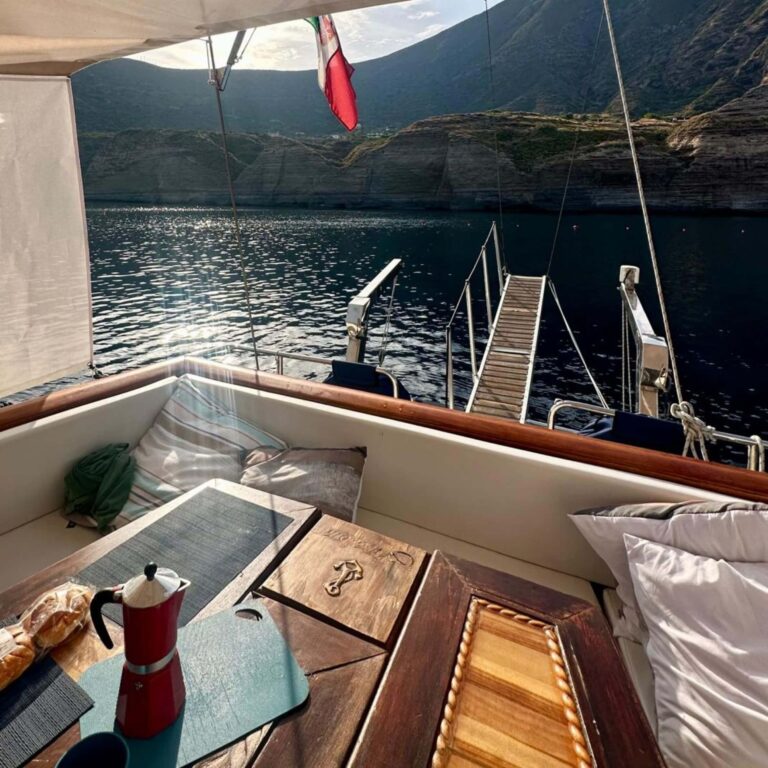

Nature and beaches in Salina
Salina isn’t called the green island by accident. When you first arrive, you’ll notice how much more fertile it feels compared to its volcanic neighbors. The two mountains, Monte Fossa delle Felci and Monte dei Porri, rise like sleeping giants, covered in forests, chestnuts, and ferns. It’s an island made for exploring, and the best way to do it is outside.
Fossa delle Felci
At 962 meters, Monte Fossa delle Felci is the highest point in the Aeolian Islands, and climbing it is a rite of passage. The trail begins gently, winding through olive trees and vineyards, before entering a forest where the air grows cool and damp. Ferns carpet the ground (the mountain is named after them), and the shade feels worlds away from the sunlit coast. When you reach the summit, the reward is one of the most breathtaking views in the archipelago: the curve of Salina below you, Lipari and Vulcano shimmering in the distance, and on a clear day, even Etna standing tall on the horizon.
It’s a climb, yes, but one that stays with you – just remember to bring some water and snacks (the total hike is around 4 hours).
Monte dei Porri
If Fossa delle Felci is the island’s queen, then Monte dei Porri is her younger, friendlier sister. At 860 meters, it’s a little lower and less challenging, but no less stunning. The path takes you up through vineyards and Mediterranean scrub, with fewer trees and more open views along the way. It’s quieter, too, sometimes you’ll feel as if you have the whole mountain to yourself. From the top, the view across to Filicudi is unforgettable, especially in the afternoon light.
Swimming spots and beaches
Salina doesn’t have long sandy beaches like some islands, but that’s part of its charm. The coastline is rugged, dramatic, and dotted with intimate places to swim.
- Scario Beach (Malfa): a pebble beach with crystal-clear water, perfect for snorkeling.
- Pollara: rocky and wild, more about atmosphere and sunsets than sunbathing, but an incredible place for a dip.
- Rinella: the island’s only real black sand beach, small but family-friendly.
- Scalo Galera and Punta Brigantino, are ideal for those who love diving from the cliffs and swimming in amazingly blue sea.
Typical food and wine in Salina
If Salina has a flavor, it’s the briny pop of a caper, the honeyed sweetness of Malvasia wine, and the freshness of fish pulled straight from the sea. The beauty of eating in Salina is that nothing feels rushed or overcomplicated. Meals are about connection and food here isn’t just fuel, it’s identity: every dish tells the story of this green island and its people.
Salina’s capers
They’re famous across Italy, and with good reason. They’re plump, fragrant, and protected by a PDO (Protected Designation of Origin), which means they can only come from here. Walk along the dry stone walls and you’ll see the plants spilling out, their delicate white flowers opening to the sun.
Capers here aren’t just a garnish. They’re at the heart of the cuisine: tossed into pasta with tomatoes, scattered over fresh fish, or simply preserved in salt to be enjoyed year-round. If you’re lucky enough to visit in late spring or early summer, you might see families harvesting them by hand, a tradition passed down through generations. Bring home a jar, it’s like bottling the taste of Salina itself.
Malvasia delle Lipari
The dessert wine that made Salina famous among wine lovers. Golden, aromatic, and kissed by the sun, it’s made from grapes that are dried on straw mats before pressing. The result is rich and sweet, with notes of apricot, honey, and Mediterranean herbs. My favourite wine ever! It pairs beautifully with almond pastries or aged cheese, but honestly, it’s just as perfect on its own, sipped slowly at sunset.
Several wineries on Salina open their doors to visitors, Azienda Agricola Fenech, Virgona, or Eolia, to name a few. Visiting one is more than a tasting; it’s a window into the island’s agricultural soul. You’ll see the terraces where the vines grow, meet the families behind the bottles, and taste wines that carry the very landscape in their flavor.
Other must-try foods
Including pasta with cucunci (caper berries), fresh swordfish, squid stewed in tomato, and of course, granita with brioche in Lingua on a hot afternoon.

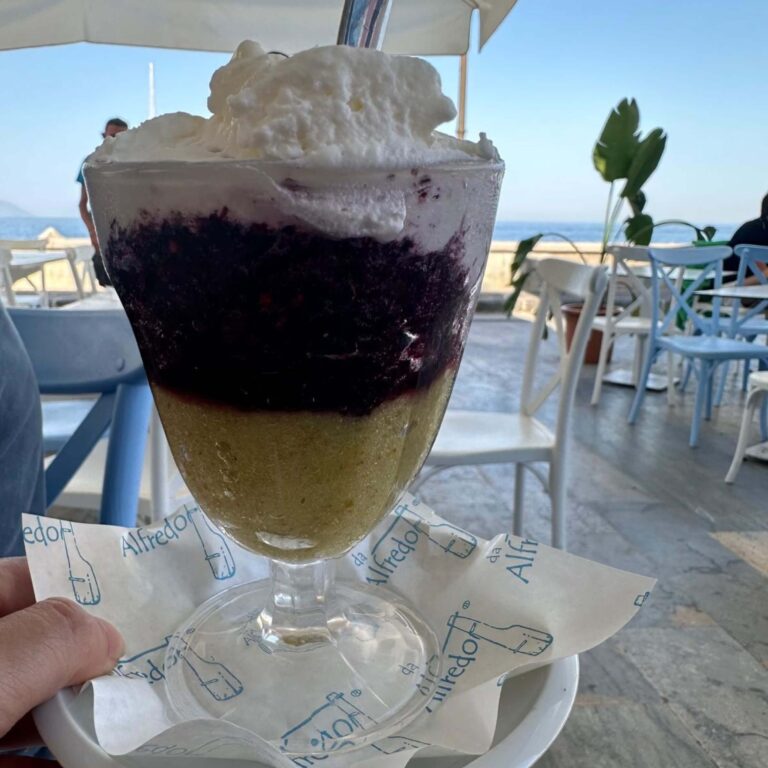
Unique experiences to try in Salina
Watch the sunset at Pollara
If there’s one ritual every visitor should experience, it’s the sunset at Pollara. The first time I experienced it, it was on a boat on my 30th birthday, and I felt like crying of joy. The cliffs curve like an ancient amphitheater, and as the sun dips toward the horizon, the whole scene glows in shades of gold and rose. It’s not just a view, it’s a memory that imprints itself deeply. No matter how many sunsets you’ve seen, this one will feel different.
Join the caper harvest
If you visit in late May or June, you might glimpse one of Salina’s most important traditions: the caper harvest. Families rise early to pick the delicate buds by hand, often under the rising sun. It’s painstaking work, but it keeps alive the tradition that has made Salina’s capers world-famous. Some farms welcome visitors to watch or even lend a hand. Joining in, even just for a few minutes, connects you directly to the island’s heritage, and when you taste capers later, you’ll remember the fields they came from.
A boat tour around the Island
Sailing around Salina is a must. Skippers know the secret caves, the best swimming coves, the dramatic lava cliffs of Pollara seen from the sea. Some will even anchor so you can dive straight into the water, an electric-blue world that makes you feel like you’re swimming in pure light. It’s one of those experiences that makes you grateful to be on an island where land and sea are inseparable.
Wine tasting at sunset
Imagine sitting on a terrace above the vineyards, a glass of golden Malvasia in hand, the sun slowly slipping behind Filicudi. I mean, is there anything else that I need to say?
Stay in a traditional Aeolian house
One of the most charming ways to live Salina is to spend a night (or a week 😜) in a traditional Aeolian house. These homes, with their whitewashed walls, thick columns, and shaded terraces, are built for island life. They stay cool in summer, frame the views perfectly, and often come with gardens where capers, figs, and lemons grow. Waking up in one feels like stepping into a postcard, but one where you’re part of the picture.
Local festivals and culture
The island’s festivals are simple, communal, and deeply tied to tradition, and if you happen to be here during one, you’ll see Salina at its most joyful.
Festa di San Lorenzo (Malfa)
Every 10th of August, the village of Malfa comes alive for the Festa di San Lorenzo, its patron saint. The celebration blends faith and festivity: there’s a solemn procession through the streets, followed by music, food stalls, and fireworks over the sea. It’s the kind of event where everyone, locals, summer visitors, kids, grandparents comes together in the piazza. Even if you don’t know a soul, you’ll be welcomed as if you do.
Festa di Santa Marina (July)
Santa Marina Salina honors its patron saint with solemn masses, processions, concerts, and festive evenings by the port.
Ferragosto (August 15)
On 15 August, the whole of Italy celebrates Ferragosto, and Salina is no exception. The island lights up with sagre (food festivals), concerts, fireworks, and beach parties. It’s a day of joy and togetherness, when locals and visitors mingle late into the night. Experiencing Ferragosto on Salina means being swept up in the energy of summer at its peak.
Music and Summer Nights:
After dinner, people drift into the piazzas to stroll, talk, and enjoy the cool air. Sometimes, there are concerts in the open air, folk music, jazz, or local bands playing by the sea.
FAQ about Salina
How do you get to Salina?
You reach Salina by ferry or hydrofoil. The quickest connections are from Milazzo (around 1.5 hours by hydrofoil). Most boats arrive at Santa Marina Salina, the main port, though some also dock at Rinella.
Can you visit Salina on a day trip?
Yes, it’s possible to visit Salina on a day trip from Lipari or even from Milazzo. But honestly, the island deserves more time.
How many days should I stay on Salina?
At least two to three nights, though four or five is even better. That way you can explore the villages, hike one of the mountains, take a boat trip, and still have time to relax.
Is Salina good for families, couples, or hikers?
All three. Families will love the calm of Rinella and the safety of small beaches, couples will find romance in Malfa and Pollara, and hikers will be thrilled by the trails up Monte Fossa delle Felci and Monte dei Porri.
Where is the best place to stay in Salina?
For convenience and variety, Santa Marina Salina offers the widest choice of hotels, B&Bs, and apartments. If you’re looking for boutique charm and romance, Malfa is ideal. Pollara has only a handful of places, but the atmosphere is unforgettable. If you prefer something authentic and more affordable, consider Rinella or Leni, which are less touristy but full of charm.
Where are the best beaches in Salina?
- Pollara: dramatic cliffs and wild scenery, perfect for sunsets.
- Rinella: one of the island’s few sandy beaches, family-friendly and lively.
- Punta Scario (Malfa): crystal-clear waters, ideal for snorkeling.
Conclusion: Why Salina stays with you
Salina isn’t an island that shouts. It whispers. What makes this island unforgettable to me is not just what you see, but what you feel. A calmness. A connection to nature. A sense that life, here, is lived more slowly and more beautifully.
When you leave, you’ll carry more than photos. You’ll carry the knowledge that somewhere out there, in the middle of the Tyrrhenian Sea, there’s a green island waiting to welcome you back.
